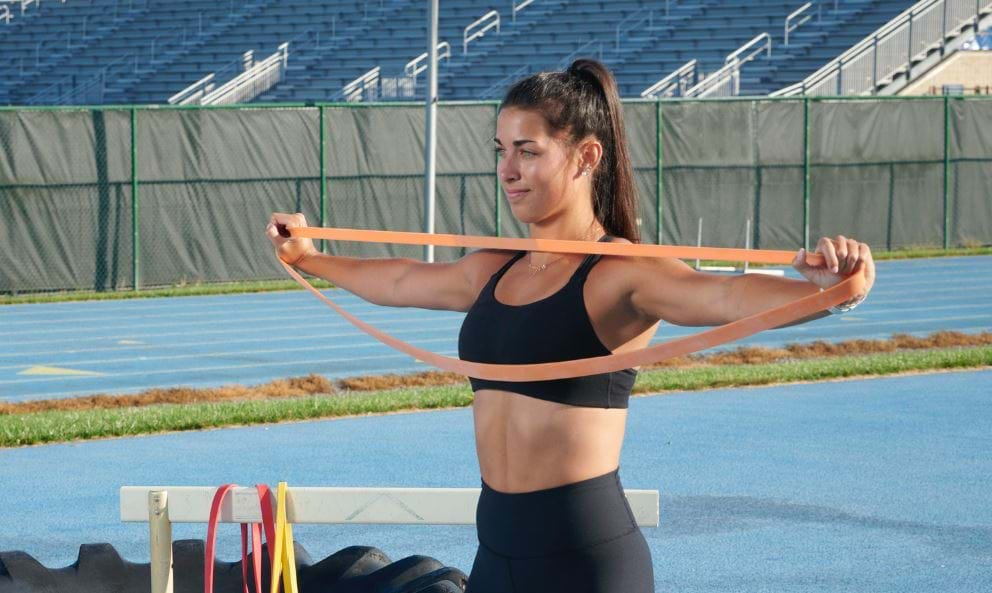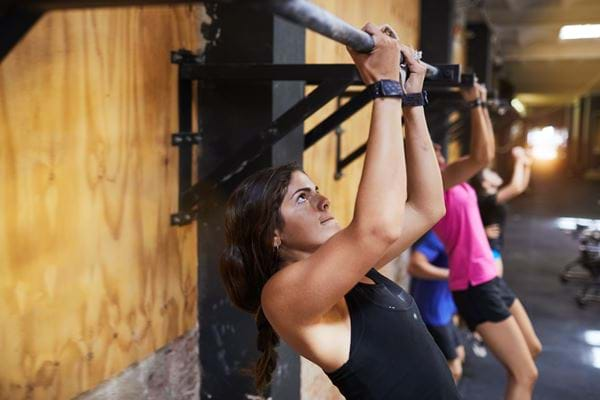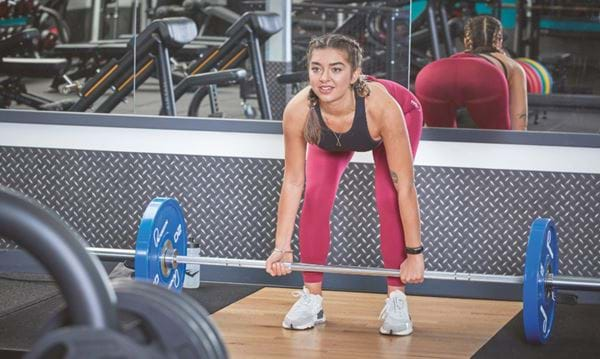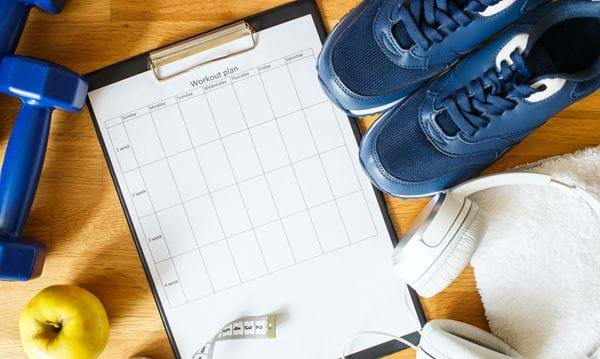9 of the Best Back Workouts

Whether you’re at home or at the gym, a complete beginner or an exercise expert, these back exercises will help boost your strength and tone your physique. We’ve included a mix of bodyweight, dumbbell and machine-based exercises so you can pick the best back workouts to suit your skillset and situation. Or, if you want a ready to follow workout, jump straight to our Back Workout For Beginners video.
Why should you do back exercises?
Integrating lower and upper back workouts into your fitness plans will help to support and strengthen your entire frame - after all, your back is the main support structure for your whole body. Boosting your back muscles will help to prevent injury and back pain, and also help to make it easier to achieve your health and fitness goals.
How often should you work out your back?
How regularly you use these back exercises depends on your goal - if this is part of a general fitness routine, then including some of these movements as part of a wider workout two or three times a week will definitely pay off. If you’re specifically focusing on boosting your back strength or muscle size, then you may want to consider including more of these targeted movements into a specialised workout, making sure to include upper and lower back exercises, as little as twice or even just once a week. Just make sure you’re pushing your muscles to fatigue by the end of each exercise.
9 Exercises to work out back muscles:
1. Resistance band pull apart
Perfect for beginners, anyone recovering from injury or simply as a gentle start to a more intense back workout, band pull aparts are easy to master and activate muscles throughout your upper back - your rhomboids, trapezius and delts all come into play here. All you need is a resistance band.
- Stand with feet hip width apart.
- Grip your band with both hands, using an overhand grip.
- Hold the band out in front of you at around chest height, with your hands about shoulder width apart and a slight bend in your elbows.
- Engage your core and rotate your shoulders outwards and your shoulder blades together.
- Pull the band apart until your upper arms are in line with your back.
- Hold for a moment before slowly easing back to the starting position.
2. Dumbbell deadlifts
Fantastic for boosting lower back strength, deadlifts come in different varieties, so you change up your style depending on which equipment you have available (or just how you feel that day). These have the added benefit of working your glutes, arms, core and so much more. You can discover more styles of deadlift over on our How to Deadlift guide, but for a basic dumbbell deadlift:
- Hold a dumbbell in each hand with palms facing the body, stand with your feet shoulder-width apart.
- Bend your knees and keep your back straight as you slowly lower into a squat position, easing the dumbbells towards the ground without allowing your back to round.
- Focus on sliding the dumbbells fairly close to your shins.
- Pause at a position where you feel a stretch in your hamstrings.
- Return to standing up straight, squeezing your glutes and keeping your core tight.
3. Single arm dumbbell row
We’re featuring a few different styles of row exercises in this guide because they’re just so fantastic for working out your back. The single arm dumbbell row engages all of your back, shoulders and arms, as well as your biceps, pecs and delts. You’ll need a dumbbell and ideally a workout bench - if you don’t have the latter then you can simply bend forward at the hips or hold a lunge position, keeping a straight back.
- Keeping your left foot on the floor, and the dumbbell in your left hand, place your right hand on the bench at around shoulder height and your right knee on the bench even with your waist. It should look like half of your body is in a tabletop position on the bench.
- Holding the dumbbell, hang your left arm down below your shoulder.
- Engaging your core, draw your left elbow back until the dumbbell is even with the left side of your chest.
- Hold for a few moments before easing back to starting position.
- When you’ve completed the reps for the left side, you can repeat on the right.
4. Wide grip cable row
Perfect for targeting the back, shoulders and biceps, wide grip cable rows are also excellent for improving core stability and keeping a straight spine. By keeping your grip a little wider than a regular cable row, you’re increasing the resistance on your upper back and shoulders. Best performed at the gym, you’ll need access to a seated row cable machine.
- Attach the seated row cable machine with a long bar handle and adjust to a suitable weight.
- Sit on the seat with feet hip-width apart, knees slightly bent and feet on the foot rests. Grab the bar handle with hands wider than shoulder width, arms extended, and palms facing each other,
- Engage your core and pull the bar handle in towards your body, just below the naval. Think about driving your elbows in towards your hips and keeping the elbows in.
- When the bar handle reaches your torso squeeze your shoulder blades for a second and then slowly extend your arms back to starting position.
5. Renegade row
The most challenging of the rows we’re featuring in this guide, renegade rows work your back, core and arm muscles, and are an excellent way for improving balance and stability. For this, you’ll need two dumbbells or kettlebells, although start with a light weight and work your way up. The key here is focusing on keeping your hips and shoulders square, your body shouldn’t be twisting or rocking at all. If it is, you may need to lower your weight.
- Assume a classic plank position but with your shoulders directly over your wrists and with your legs spread wide apart - they should be wider than shoulder width.
- Take a dumbbell in each hand, so your weight is on the dumbbell rather than your hands - stay strong through your wrists.
- Position your weight through the right hand side of your body and engage your core.
- Drive the left dumbbell upwards toward chest-level, pulling your elbow up and back, while keeping your arm tucked in alongside your body.
- Gently ease back to start position before alternating to your right arm.
- Focus on squeezing your glutes and abs to keep your body in a steady position - you shouldn’t feel any rocking.
6. Chin up
Taking on the challenge of a chin up works a wealth of back, arm, chest and core muscles, including the lats, biceps, trapezius and pecs. You’ll just need access to a high bar, climbing frame or sturdy doorframe. You can also vary between chin ups and pull ups - the only difference is that for chin ups, your palms are facing your chin and in a pull up, your palm is facing away from you as you grab the bar.
- Take the bar with both hands, with your palms facing you and arms around shoulder-width apart.
- Engaging your core, pull yourself up until your chin is raised above the bar and your elbows are fully bent.
- Hold for a moment before gently lowering yourself back down until your arms are mostly straight.
7. Kettlebell swings
Requiring just one piece of equipment (the kettlebell), kettlebell swings work the lower back, glutes, hamstrings, core and shoulders, so are really a full body workout in one. Great for strengthening muscles and boosting endurance, this functional move can also help to improve your cardio fitness. Start with lighter weights until you’re comfortable with the move.
- Stand with your back straight and feet shoulder-width apart. Lower into a half-squat and pick up the kettlebell with both hands so your palms are facing your body.
- Engage your core and bend your knees slightly as you straighten your legs, push from the heels, explode through the hips and swing the kettlebell to chest height.
- As you swing the kettlebell down between your legs, return to the half-squat position. That's one rep.
Check out our kettlebell swings page for more information and variations.
8. Farmer’s walk
Great for improving posture, strengthening your grip and targeting your upper back muscles and shoulders, the farmer’s walk is definitely uncomplicated… but don’t let that fool you into thinking it’s easy. In fact, one of the joys of the farmer’s walk is you can quickly and easily build the weight for maximum results. This is also a fantastic move for your abs, legs, glutes, arms and core. You’ll need a couple of equal-weighted kettlebells for this exercise.
- Stand with feet hip-width apart and a kettlebell (or dumbbell) either side of you.
- Pushing your hips back, bend your knees to grab your weights, before returning to standing.
- With the weights at your side, core engaged, body straight and shoulder blades down, walk forward with the weight, for either a set amount of time or a specific number of steps.
- Move faster to boost your cardio.
9. Superman
One of the best equipment-free back-targeting exercises you can do, the superman is an excellent lower back workout that also targets your hamstrings, abs and glutes. All you need is a mat or slightly cushioned surface to lie on.
- Lie face down on the ground, with your legs straight and your arms stretched above your head on the floor.
- Engaging your core, lift your arms and legs around 6 inches off the ground in a slow, controlled movement, keeping your eyes facing the floor and your head steady.
- Hold for a few seconds before gently lowering back to the floor.
There are many different variations of the superman, including ‘dead stop to superman’, which incorporates push ups between each lift, or the ‘pullup superman’, in which you keep your torso up and move your arms forwards and backwards in a pullup motion. Try a few different styles to mix up your back workout.
Beginner Back Workout
If you want a ready made back workout that’s easy to follow and will help you to build muscle and strength, give this a try.
You can repeat this workout each week. Just increase the number of reps, or the weight, to make sure you continue to challenge your muscles.
Complete 3-4 sets of each exercise, with 8-12 reps per set.
- Diverging Lat Pulldown
- Single Arm Row
- Prone Fly
- Kneeling High Cable Row
- Supermans With Lat Pull
Head over to our arm and shoulder workouts page for more upper body exercise inspiration, or check out our Back Exercises for Beginners guide for more ideas. You can also download the free PureGym app, where you can create a customised training plan for your fitness goals or get involved with our on-demand classes and workouts. Not sure where to start? You could consider booking a session with a dedicated Personal Trainer at PureGym - they’re able to offer a wealth of advice for both fitness and nutrition.


